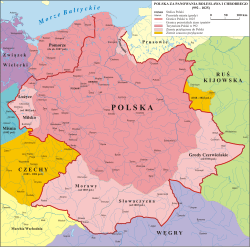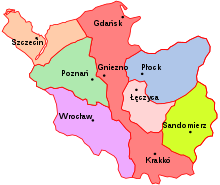Kingdom of Poland
Kingdom of Poland
| |||||||||
|---|---|---|---|---|---|---|---|---|---|
| 1025–1385 | |||||||||
 Kingdom of Poland in 1025 | |||||||||
 Kingdom of Poland in 1370 | |||||||||
| Capital | |||||||||
| Official languages | Polish, Latin | ||||||||
| Religion |
| ||||||||
| Demonym(s) | Polish | ||||||||
| Government | Hereditary Feudal monarchy | ||||||||
| Historical era | Middle Ages | ||||||||
| Currency | |||||||||
| |||||||||
The Kingdom of Poland (Polish: Królestwo Polskie; Latin: Regnum Poloniae) was a monarchy in Central Europe during the medieval period from 1025 until 1385.
Background
The
History
Establishment

In 1025,
Casimir I the Restorer managed to reunite parts of the kingdom following the crisis and moved the capital to Kraków. However, he failed to reinstitute the monarchy due to opposition from the Holy Roman Emperor.[4] In 1076, Bolesław II the Bold, with the support of Pope Gregory VII, regained the royal crown but was later excommunicated and banished from the kingdom in 1079 for murdering his opponent, Bishop Stanislaus of Szczepanów. In 1079, Władysław I Herman, who never pursued kingship took over the reins after the expulsion of Bolesław II. Władysław I was disinterested in becoming king and the country was effectively run by wojewoda Sieciech.
Feudal fragmentation

In 1102,
During the first half of the 13th century, the
Reunited kingdom

The next attempt to restore the monarchy and unify the Polish kingdom would occur in 1296, when
, who expanded into Red Ruthenia. However, he had to renounce his claims to Silesia in order to secure peace with the Holy Roman Empire. Casimir III is the only Polish king to receive the title "Great", and his reign was marked by substantial developments in the kingdom's urban infrastructure, civic administration, and military strength. After his death on 5 November 1370, the rule of the Piast dynasty would come to an end.Following the death of Casimir III, who died without an heir,
See also
- List of Polish monarchs
- History of Poland in the Middle Ages
- Culture of medieval Poland
- History of Poland
References
- ISBN 978-8-323-13886-0.
- ISBN 978-8-323-13886-0.
- ISBN 978-83-909852-1-3.
- ^ "Casimir I". Encyclopedia Britannica. 2023. Retrieved 8 January 2024.
As ruler of Poland, however, he was never crowned king, and German suzerainty over Poland was in fact reestablished during his reign.
- ISBN 83-7063-409-5.
- ISBN 9780826037404.
- ISBN 83-08-02829-2.
there are no preserved information about a papal consent for the coronations of Wenceslaus II in 1300 and Ryksa-Elisabeth in 1303.
- ISBN 978-0-88033-206-4.


